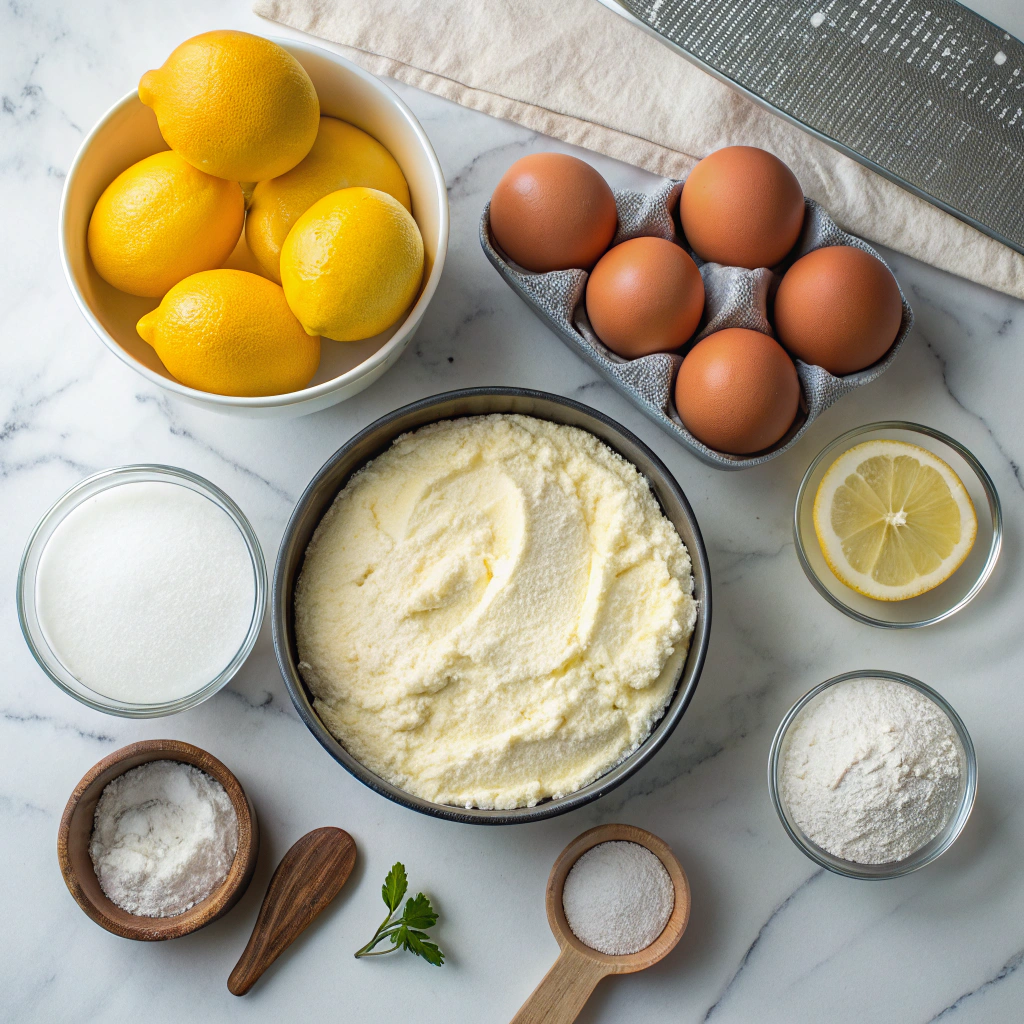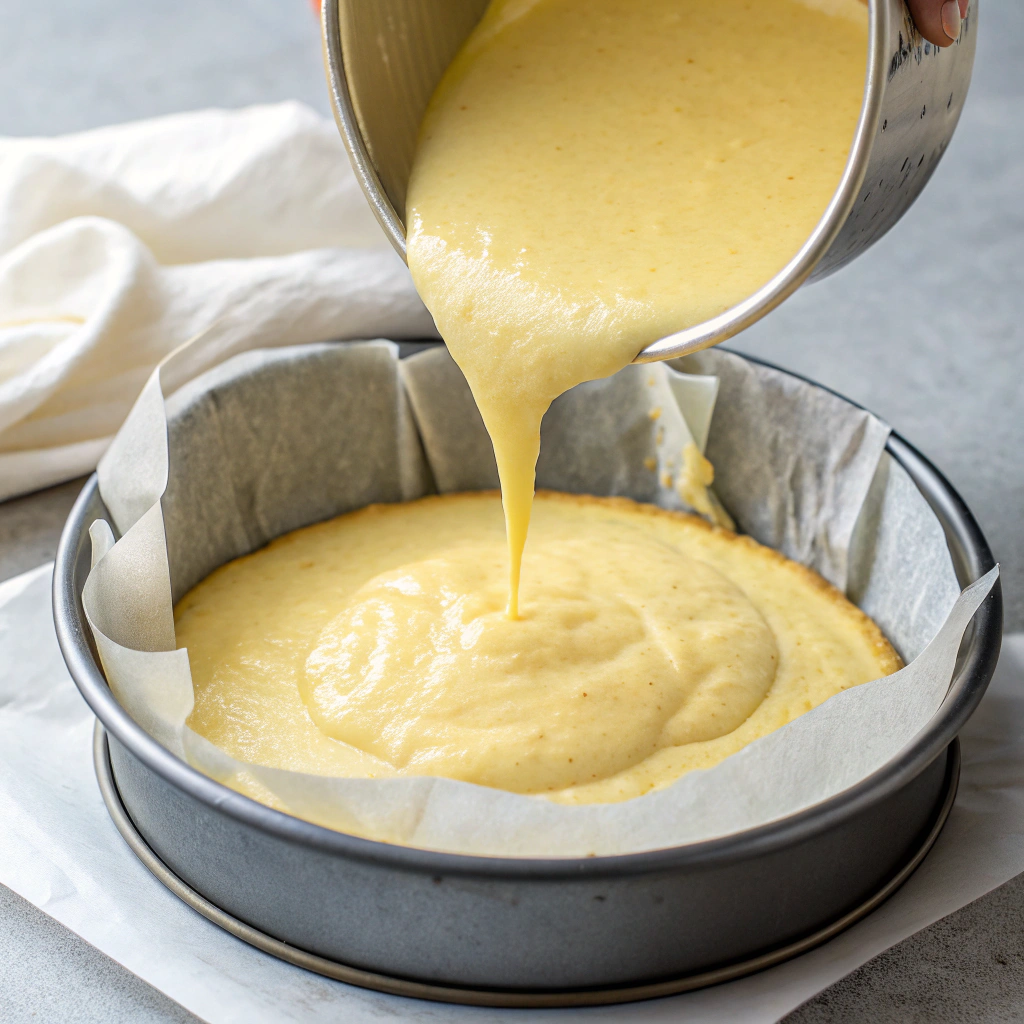
There’s something about the combination of lemon and cottage cheese that just feels right. Maybe it’s the way the citrus cuts through the creaminess, or how both ingredients bring out each other’s best qualities. Either way, this lemon cottage cheese cake is everything I love in a dessert: simple, satisfying, and sneakily healthy. It started as a fridge-clearing experiment one rainy afternoon, and now it’s a regular on our weekend table. If you’ve never tried baking with cottage cheese before, this recipe will change your mind — and your taste buds will thank you for it.
Print
Lemon Cottage Cheese Cake
- Total Time: 50 minutes
- Yield: 8 slices
Description
This moist and protein-rich lemon cottage cheese cake blends citrus brightness with creamy texture, making it a light yet indulgent dessert option.
Ingredients
- 1 cup cottage cheese (blended until smooth)
- 3/4 cup granulated sugar
- 2 large eggs
- 1 tablespoon lemon zest
- 1 teaspoon lemon extract (optional)
- 1/2 cup all-purpose flour
- 1/2 teaspoon baking powder
- 1/4 teaspoon salt
- Powdered sugar and fresh berries for serving (optional)
Instructions
- Preheat oven to 325°F (160°C). Grease a 9-inch round cake pan.
- In a blender or food processor, blend cottage cheese until completely smooth.
- In a bowl, whisk sugar and eggs until light and fluffy. Mix in lemon zest and lemon extract if using.
- Stir in the blended cottage cheese.
- In another bowl, whisk together flour, baking powder, and salt.
- Gradually mix the dry ingredients into the wet mixture until just combined.
- Pour batter into prepared pan and smooth the top.
- Bake for 35–40 minutes or until the center springs back and a toothpick comes out clean.
- Cool in the pan for 15–20 minutes, then transfer to a wire rack to cool completely.
- Serve with powdered sugar and berries if desired.
Notes
Use a fine microplane for zesting and an oven thermometer for best baking results. Low-fat cottage cheese can be used for a lighter version.
- Prep Time: 10 minutes
- Cook Time: 40 minutes
- Category: Dessert
- Method: Baking
- Cuisine: American
Table of Contents
Table of Contents
Why This Lemon Cottage Cheese Cake Works So Well
The Secret Ingredient That Makes It Moist
You might be wondering, “Cottage cheese in cake? Really?” But trust me — once you try this lemon cottage cheese cake , you’ll never look at cottage cheese the same way again. The secret lies in its texture. When blended smooth, cottage cheese becomes incredibly creamy, almost like ricotta or mascarpone — but with fewer calories and more protein. That means every slice of this cake is rich without being heavy, moist without being dense, and indulgent without the guilt.
This unique ingredient keeps the cake soft and tender by locking in moisture. Unlike traditional cakes that rely on butter or oil for richness, this version gets its luscious texture from something unexpected yet totally delicious: cottage cheese. It blends beautifully into the batter, giving the cake a silky finish that melts in your mouth.
If you’re curious about other ways to use cottage cheese beyond dessert, check out my cottage cheese salad for a refreshing lunch idea or try my cottage cheese eggs for a creamy breakfast boost. There’s also my cottage cheese dip magic for snack time and cottage cheese bagels when you want something savory.
So whether you’re baking for health, flavor, or just because it tastes amazing, this cake proves that cottage cheese has a place in your dessert rotation.
How Cottage Cheese Elevates Texture and Nutrition
Let’s talk about the real MVP here: cottage cheese. It’s not just a sneaky way to add protein — it actually improves the texture of the cake in a big way. Because it holds moisture so well, it keeps the crumb soft and tender without drying out. That’s why this lemon cottage cheese cake stays fresh for days and reheats beautifully, making it perfect for meal prep or weekday snacks.
Nutritionally, cottage cheese brings a lot to the table. It’s packed with casein protein, which digests sluggishly and helps keep you full longer. It also contains calcium, B vitamins, and even some probiotics if you use live-culture cottage cheese. All of that in a dessert? Yes, please.
The beauty of this recipe is how it transforms a humble ingredient into something truly special. You do n’t need fancy ways or rare constituents — just a blender, a coliseum, and a little curiosity. Whether you drizzle it with a light lemon glaze or serve it plain, this cake always feels like a treat, minus the guilt.
And if you’ve got a container of cottage cheese sitting in the fridge right now, I bet you’re already thinking of all the ways you can put it to work — starting with this cake.
How to Make Lemon Cottage Cheese Cake Moist
Blend Cottage Cheese Until Smooth

The secret to a moist lemon cottage cheese cake starts with how you prepare the cottage cheese. If you skip this step or do it halfway, you’ll end up with a lumpy batter and a dry final result. To avoid that, always blend the cottage cheese until it’s silky smooth before adding the other ingredients.
I use a high-speed blender or food processor for best results. Pulse it a few times, then let it run until the texture becomes creamy — almost like soft cream cheese. This takes just a couple of minutes but makes a huge difference in the cake’s overall consistency.
Blending helps break down the curds and releases some of the natural moisture in the cottage cheese. That means more even distribution in the batter and a tender crumb in the finished cake. It also prevents dry pockets and ensures every bite is rich and flavorful.
Don’t worry — this doesn’t change the nutritional value or take away from the health benefits. You still get all the protein and calcium, but with a much better mouthfeel. Once you try it this way, you won’t go back.
Add Just the Right Amount of Citrus Zest
Zest is what brings this lemon cottage cheese cake to life. It adds brightness, aroma, and depth without overpowering the creamy base. But not all zesting techniques are created equal — so here’s how I do it for maximum flavor impact.
I always use fresh lemons and a fine microplane grater to extract only the colored part of the peel — the zest. The white pith underneath can be bitter, so I avoid grating too deeply. One medium lemon usually gives me about a tablespoon of zest, which is perfect for this recipe.
I mix the zest directly into the batter rather than adding it latterly. That way, the citrus oils infuse the entire cake, giving it a more balanced flavor. If you wait until after mixing, some of the volatile oils can evaporate, leaving your cake tasting flat.
For extra punch, I sometimes add a teaspoon of lemon extract along with the zest. It enhances the citrus notes and ensures the lemon flavor shines through, even with all that creamy cottage cheese.
So don’t skip the zest — it’s one of the key elements that turns this cake from ordinary to unforgettable.
Baking the Perfect Lemon Cottage Cheese Cake: Time, Temperature & More
Bake at the Right Temperature for Even Rise

Getting the oven temperature just right is one of the most important steps in making a flawless lemon cottage cheese cake . Too hot, and the outside browns too fast while the inside stays undercooked. Too cool, and the cake won’t rise properly, leaving you with a dense, gummy texture.
I always bake this cake at 325°F (160°C). That moderate heat gives it time to set without drying out or cracking on top. I also make sure my oven rack is positioned in the lower third — this helps prevent the top from browning too quickly while the bottom cooks evenly.
One trick I swear by? Using an oven thermometer. Most ovens aren’t perfectly calibrated, and even a 10–15 degree difference can throw off your results. A quick glance at the thermometer lets me know if I need to adjust the setting for perfect baking conditions.
And if you’re using a convection oven, reduce the temperature by about 25°F and keep an eye on the cake — convection baking tends to cook faster and more evenly.
This careful balance of heat ensures every lemon cottage cheese cake comes out tall, tender, and golden all the way through.
Know When It’s Done Without Overbaking
Timing is everything when it comes to pulling your lemon cottage cheese cake out of the oven at just the right moment. Overbake it, and you risk drying it out. Underbake it, and the center might sink or feel undercooked.
I use two simple tests to check doneness. First, I gently press the center of the cake — if it springs back, it’s done. Still, it needs a many further twinkles, If it leaves an indentation.
Second, I insert a toothpick or thin skewer near the center. still, the cutlet is ready, If it comes out clean or with just a many wettish motes. If there’s wet batter clinging to it, give it another 5–7 minutes and test again.
I also turn off the oven a few minutes before the timer goes off and let the residual heat finish the job. This gentle approach helps help overbaking and keeps the scruple soft and wettish.
Once it’s out, I let the cake cool in the pan for about 15–20 minutes before loosening the edges and transferring it to a wire rack. That little rest makes slicing easier and improves the texture even more.
Serving and Storing Your Lemon Cottage Cheese Cake
How to Slice and Serve for Maximum Enjoyment
Once your lemon cottage cheese cake has cooled completely, it’s time to serve — and how you slice it can make all the difference. I always use a long, sharp saw-toothed cutter for clean cuts. A regular chef’s knife can squish the delicate crumb or tear through the soft center, especially if the cake still has some warmth.
Before slicing, I wipe the blade between cuts with a warm, damp cloth. This helps prevent sticking and ensures each piece looks as good as it tastes. For even slices, I measure the cake first and make light guide marks around the top before cutting all the way through.
I love serving this lemon cottage cheese cake with a dusting of powdered sugar and a few fresh berries for color and contrast. It adds a touch of fineness without complicating the flavors. If I want something richer, a dollop of whipped cream or a drizzle of honey does wonders.
For a more casual setting, I often just place the whole cake on a wooden board, slice it at the table, and pass it around. It always disappears fast — usually before I get a second slice!
And do n’t forget — this cutlet shines indeed brighter when served with a warm mug of tea or a glass of cold almond milk. Either way, it’s a treat that feels special, yet totally doable.
Best Ways to Store and Reheat Without Losing Flavor
To keep your lemon cottage cheese cake tasting fresh and moist, proper storage is key. I wrap any leavings tightly in plastic serape or store them in an watertight vessel. At room temperature, it stays soft and flavorful for up to two days. If you want to stretch that shelf life a bit further, refrigeration is your best bet — the cake keeps well in the fridge for up to five days.
When reheating, I avoid the microwave oven unless I’m in a real hurry. It tends to make the texture gummy. Instead, I prefer warming individual slices in a toaster oven or on a baking sheet in a preheated 300°F (150°C) oven for about 5–7 minutes. That gentle heat brings back the cake’s original softness and aroma without drying it out.
If I’ve made a glaze or topping separately, I always add it after reheating — that way, it melts slightly and enhances the flavor even more. And if you’re like me and always want a little extra lemon kick, a quick brush of lemon syrup over the top revives the brightness beautifully.
With these tips, your lemon cottage cheese cake stays just as delicious the next day — maybe even better.
Frequently Asked Questions
Is lemon cottage cheese cake healthy?
Yes, lemon cottage cheese cake is a healthier dessert option compared to traditional cakes. Cottage cheese adds protein and calcium while keeping the fat content low. This makes it a satisfying treat that supports muscle repair and digestion. If you’re looking for more high-protein recipes, try my cottage cheese eggs or cottage cheese salad .
How do you make lemon cottage cheese cake moist?
To keep your lemon cottage cheese cake moist, blend the cottage cheese until smooth before mixing into the batter. This ensures even distribution and a creamy texture. Also, avoid overbaking — pull the cake from the oven just as the center sets. A little rest time helps lock in moisture too.
Can I use low-fat cottage cheese in cake?
Absolutely. Low-fat cottage cheese works well in this recipe and keeps the calorie count lower without sacrificing flavor. Just be sure to blend it thoroughly to maintain a silky texture. Using low-fat doesn’t mean low taste — this lemon cottage cheese cake still comes out rich and satisfying.
What does cottage cheese do in baking?
Cottage cheese adds moisture, structure, and protein to baked goods. In this lemon cottage cheese cake , it acts like a lighter alternative to ricotta or cream cheese, giving the cake a tender crumb and subtle tanginess. It also enhances nutritional value, making your dessert feel guilt-free but still indulgent.
